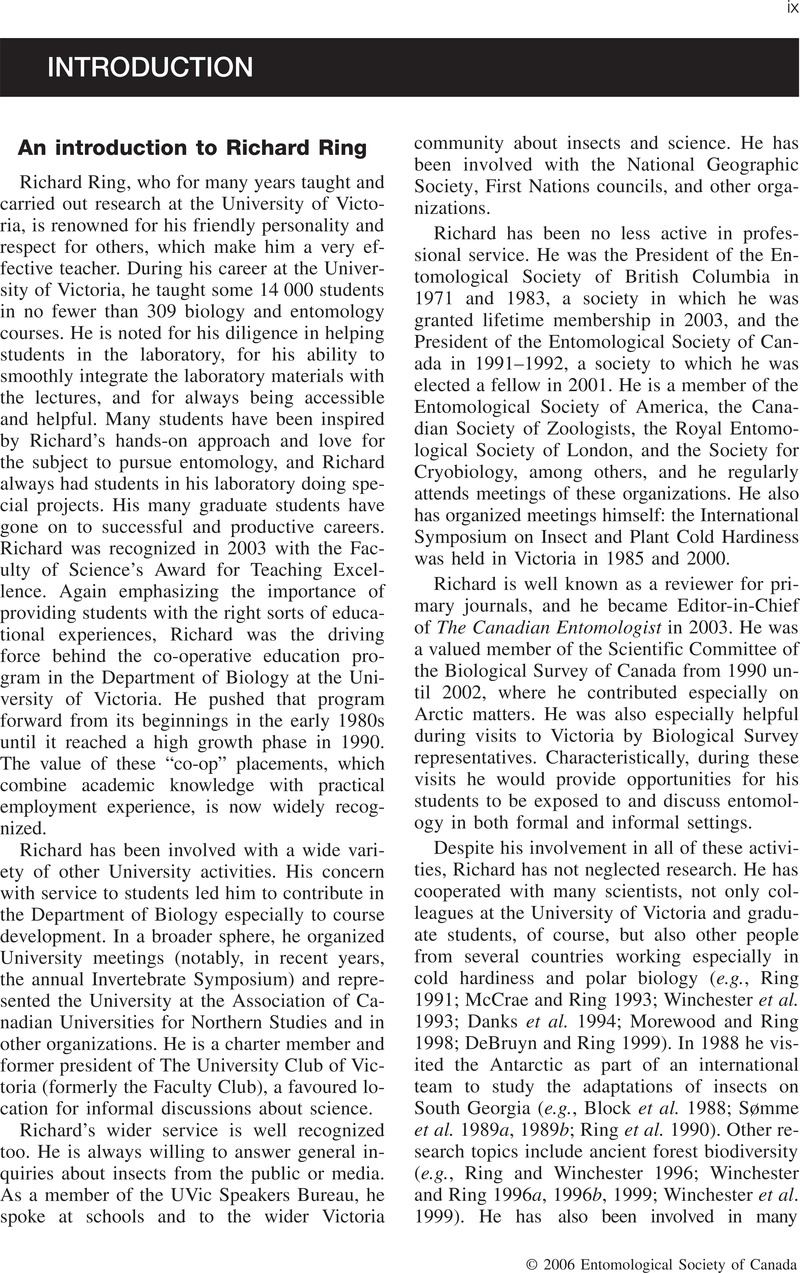No CrossRef data available.
Article contents
An Introduction to Richard Ring / Présentation de Richard Ring
Published online by Cambridge University Press: 02 April 2012
Abstract
An abstract is not available for this content so a preview has been provided. Please use the Get access link above for information on how to access this content.

- Type
- Introduction
- Information
- Copyright
- Copyright © Entomological Society of Canada 2006
References
Block, W., Sømme, L., Ring, R., Ottesen, P., and Worland, M.R. 1988. Adaptations of arthropods to the sub-Antarctic environment. Antarctic Science, 5: 17–24.Google Scholar
Danks, H.V., Kukal, O., and Ring, R.A. 1994. Insect cold-hardiness: insights from the Arctic. Arctic, 47: 391–404.CrossRefGoogle Scholar
DeBruyn, A.M.H., and Ring, R.A. 1999. Comparative ecology of two species of Hydroporus (Coleoptera: Dytiscidae) in a high arctic oasis. The Canadian Entomologist, 131: 405–420.CrossRefGoogle Scholar
McCrae, I.V., and Ring, R.A. 1993. Life history of Cricotopus myriophylli Oliver (Diptera: Chironomidae) in the Okanagan Valley, BC. The Canadian Entomologist, 125: 979–985.CrossRefGoogle Scholar
Morewood, D.M., and Ring, R.A. 1998. Revision of the life history of the High Arctic moth Gynaephora groenlandica (Wocke) (Lepidoptera: Lymantriidae). Canadian Journal of Zoology, 76: 1371–1381.CrossRefGoogle Scholar
Ring, R.A. 1977. Cold hardiness of the bark beetle, Scolytus ratzeburgi Jans. (Coleoptera, Scolytidae). Norwegian Journal of Entomology, 24: 125–136.Google Scholar
Ring, R.A. 1980. Insects and their cells. In Principles and practice of low temperature preservation in medicine and biology. Edited by M.J. Ashwood-Smith and J. Farrant. Pitman Medical, London. pp. 187–217.Google Scholar
Ring, R.A. 1981. The physiology and biochemistry of cold tolerance in arctic insects. Journal of Thermal Biology, 6: 219–229.CrossRefGoogle Scholar
Ring, R.A. 1982. Freezing-tolerant insects with low supercooling points. Comparative Biochemistry and Physiology A, 73: 605–612.CrossRefGoogle Scholar
Ring, R.A. 1983. Cold tolerance in Canadian arctic insects. In Plant, animal, and microbial adaptations to terrestrial environments. Edited by Margaris, N.S., Arianoutsou-Faraggitaki, M., and Reiter, R.J.. Plenum, New York. pp. 17–29.CrossRefGoogle Scholar
Ring, R.A. 1991. The insect fauna and some other characteristics of natural salt springs on Saltspring Island, British Columbia. In Arthropods of springs, with particular reference to Canada. Edited by Williams, D.D. and Danks, H.V.. Memoirs of the Entomological Society of Canada, 155: 51–61.Google Scholar
Ring, R.A., and Danks, H.V. 1994. Desiccation and cryoprotection: overlapping adaptations. CryoLetters, 15: 181–190.Google Scholar
Ring, R.A., and Danks, H.V. 1998. The role of trehalose in cold-hardiness and desiccation. CryoLetters, 19: 275–282.Google Scholar
Ring, R.A., and Tesar, D. 1980. Cold hardiness of the arctic beetle, Pytho americanus Kirby (Coleoptera, Pythidae (Salpingidae)). Journal of Insect Physiology, 26: 763–774.CrossRefGoogle Scholar
Ring, R.A., and Tesar, D. 1981. Adaptations to cold in arctic insects. Cryobiology, 18: 199–211.CrossRefGoogle ScholarPubMed
Ring, R.A., and Winchester, N.N. 1996. Coastal temperate rainforest canopy access systems in British Columbia, Canada. Selbyana, 17: 22–26.Google Scholar
Ring, R.A., Block, W., Sømme, L., and Worland, M.R. 1990. Body water content and desiccation resistance in some arthropods from subantarctic South Georgia. Polar Biology, 10: 581–588.CrossRefGoogle Scholar
Sømme, L., Ring, R.A., Block, W., and Worland, M.R. 1989 a. Respiratory metabolism of Hydromedion sparsutum and Perimylops antarcticus (Col., Perimylopidae) from South Georgia. Polar Biology, 10: 135–139.Google Scholar
Sømme, L., Ring, R.A., Block, W., and Worland, M.R. 1989 b. Feeding in two phytophagous beetles, Hydromedion sparsutum and Perimylops antarcticus from South Georgia. Polar Biology, 10: 141–143.Google Scholar
Winchester, N.N., and Ring, R.A. 1996 a. Northern temperate coastal Sitka spruce forests with special emphasis on canopies: studying arthropods in an unexplored frontier. Northwest Science, 70: 94–103.Google Scholar
Winchester, N.N., and Ring, R.A. 1996 b. Centinelan extinctions: extirpation of northern temperate old-growth rainforest arthropod communities. Selbyana, 17: 50–57.Google Scholar
Winchester, N.N., and Ring, R.A. 1999. The biodiversity of arthropods from northern temperate ancient coastal rainforests: conservation lessons from the high canopy. Selbyana, 20: 268–275.Google Scholar
Winchester, N.N., Wiggins, G.B., and Ring, R.A. 1993. The immature stages and biology of the unusual North American caddisfly Sphagnophylax meiops with consideration of the phyletic relationships of the genus (Trichoptera: Limnephilidae). Canadian Journal of Zoology, 71: 1212–1220.CrossRefGoogle Scholar
Winchester, N.N., Behan-Pelletier, V.M., and Ring, R.A. 1999. Arboreal specificity, diversity and abundance of canopy-dwelling oribatid mites (Acari: Oribatida). Pedobiologia, 43: 1–10.CrossRefGoogle Scholar




